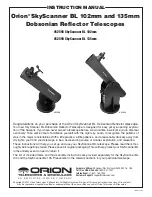
rooftops and chimneys, as they often have warm air currents
rising from them. Similarly, avoid observing from indoors
through an open (or closed) window, because the tempera-
ture difference between the indoor and outdoor air will cause
image blurring and distortion.
If at all possible, escape the light-polluted city sky and head
for darker country skies. You’ll be amazed at how many more
stars and deep-sky objects are visible in a dark sky!
“Seeing” and Transparency
Atmospheric conditions vary significantly from night to night.
“Seeing” refers to the steadiness of the Earth’s atmosphere at
a given time. In conditions of poor seeing, atmospheric turbu-
lence causes objects viewed through the telescope to “boil”.
If, when you look up at the sky with your naked eyes, the stars
are twinkling noticeably, the seeing is bad and you will be lim-
ited to viewing with low powers (bad seeing affects images at
high powers more severely). Planetary observing may also be
poor.
In conditions of good seeing, star twinkling is minimal and
images appear steady in the eyepiece. Seeing is best over-
head, worst at the horizon. Also, seeing generally gets better
after midnight, when much of the heat absorbed by the Earth
during the day has radiated off into space.
Especially important for observing faint objects is good “trans-
parency”—air free of moisture, smoke, and dust. All tend to
scatter light, which reduces an object’s brightness. Trans-
parency is judged by the magnitude of the faintest stars you can
see with the unaided eye (6th magnitude or fainter is desirable).
If you cannot see stars of magnitude 3.5 or dimmer then con-
ditions are poor. Magnitude is a measure of how bright a star
is—the brighter a star is, the lower its magnitude will be. A
good star to remember for this is Megrez (mag. 3.4), which is
the star in the “Big Dipper” connecting the handle to the “dip-
per”. If you cannot see Megrez, then you have fog, haze,
clouds, smog, or other conditions that are hindering your
viewing Figure 11).
Eyepiece Selection
By using eyepieces of different focal lengths, it is possible to
attain many magnifications or powers with the Observer 70.
Your telescope comes with two Explorer II eyepieces (Figure
12): a 25mm, which gives a magnification of 28x, and a
10mm, which gives a magnification of 70x. Other eyepieces
can be used to achieve higher or lower powers. It is quite
common for an observer to own five or more eyepieces to
access a wide range of magnifications.
To calculate the magnification, or power, of a telescope-eye-
piece combination, simply divide the focal length of the tele-
scope by the focal length of the eyepiece:
Telescope Focal Length (mm)
Magnification =
Eyepiece Focal Length (mm)
For example, the Observer 70 EQ, which has a focal length of
700mm, used in combination with the 25mm eyepiece, yields
a magnification of:
700mm
= 28x
25mm
Whatever you choose to view, always start by inserting your
lowest-power (longest focal length) eyepiece to locate and
center the object. Low magnification yields a wide field of
view, which shows a larger area of sky in the eyepiece. This
makes finding and centering an object much easier. Trying to
Figure 11.
Megrez connects the Big Dipper’s handle to it's “pan”.
It is a good guide to how conditions are. If you can not see Megrez
(a 3.4 mag star) then conditions are poor.
16
Light Pollution
Most of us live where city lights interfere with our view
of the heavens. As our metropolitan areas have become
more developed, the scourge of light pollution has
spread, washing out many stars and nonstellar celestial
objects from our sight. Faint deep sky objects become
difficult or impossible to see through the murk of light
pollution. Even bright nebulas like the Orion and Lagoon
Nebulas lose much of their delicate detail. The Moon
and planets are not affected; they require steady air
more than dark skies, so they remain good targets for
city-dwelling observers.
The International Dark-Sky Association is waging the
fight against light pollution. The IDSA was founded in
1988 with the mission of educating the public about the
adverse impact that light pollution has on the night sky
and astronomy. Through educational and scientific
means, the nonprofit IDA works to raise awareness
about the problem and about measures that can be
taken to solve it.
Do you need help dealing with local officials to control
street or building lighting in your area? The IDA’s exten-
sive support materials can show you how. Help pre-
serve dark skies, join the IDA today! For information,
write to IDA, 3225 N. First Ave., Tuscon, AZ 85719-2103
or visit their website: www.darksky.org.
The best way to avoid immediate problems with light pol-
lution, however, is to take you telescope to where there
are dark skies. You will be amazed at how many stars
you can see when you get away from the city lights.
2.4
1.7
3.4
2.4
4.9
1.9
1.9
2.5
Содержание Observer 70 EQ 9882
Страница 2: ...2 ...
Страница 4: ...4 2 3 4 5 6 7 8 1 Observer 70 Refractor 9 11 12 10 13 Figure 1 Observer 70 EQ Components ...
Страница 19: ...19 ...





































